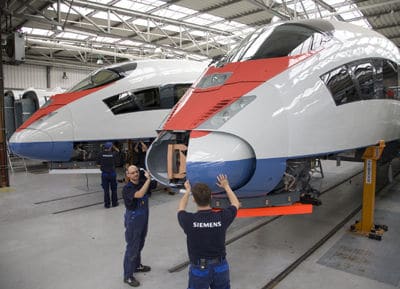A high speed rail line between Houston and Dallas has a head start, but North Texas transportation officials say Dallas-Fort Worth is the key link to a statewide system potentially stretching from Oklahoma to Mexico.
And Regional Transportation Council’s recent $4.5 million 3-year allocation will fund engineering reports needed to attract investors like the Japanese-backed firm that is building the Houston-Dallas line, regional officials say.
“Yes, this is a big deal,” said Bill Meadows, chair of the Texas High Speed Rail Commission that is partnering with the Texas Department of Transportation and North Central Texas Council of Governments and RTC to develop the Dallas to Fort Worth route as well other high speed rail routes in the state.
Meadows said TxDOT is in the midst of a federally-funded environmental impact study for the D-FW route that is expected to be completed by 2017 – about the same time construction is scheduled to begin on the Houston-Dallas line.
“When a project runs in the billions of dollars, $4.5 million may not sound like a lot,” he said. “But this is a really definitive step that will enable us to develop good information vital to anyone looking at the project to have a good sense how great the potential is.
That information, to be developed through engineering studies led by NCTCOG transportation director Michael Morris, will be contained in “requests for information” packets Meadows hopes to seek from potential U.S. and foreign investors.
“It’s no secret that the French have had an interest in us in the past,” he said. “ Other parties have come to our attention in the last several months. Because of those interested parties and developing interest in this corridor, it’s important that we have a process established. This funding will enable us to develop that process.”
Morris, who has been coordinating high speed rail planning since 2012 with a $1.4 million RTC grant, said the $4.5 million allocation – $1.5 million a year for 2016-2018 – will prepare regional officials to move into the next phase –designing a Dallas-Fort Worth leg that investors will want to build.
Fort Worth Mayor Betsy Price said the RTC funding is definitely a good sign for the future of high speed rail in Fort Worth.
“We’ve been talking about it for a couple of years. To put dollars behind it makes it more of a strong probability, It puts it more in the reality realm,” Price said.
Although there is some rural opposition to high speed rail, Price said most local officials view it as a positive transportation option as do many citizens and even the airlines that could view it as competition.
“Imagine the opportunity to have breakfast with your family, take the train to Houston for business and be back in time for dinner with your family,” she said.
Price said government can no longer build enough roads to accommodate increasing traffic in and between its urban centers, making high speed rail “the ideal thing to do.”
“So far we’re not getting any push back from the airlines. That may come later but right now their real focus is longer hops than Houston, “ Price said.
Preliminary engineering will include facets as big as interfacing with the Highway 360-Interstate 30 exchange – if the Dallas-Fort Worth line is built along I-30 – to designing rail stations and platforms within stations, he said.
“We’re not saying the who yet, but we’re starting to lay out what we’re going to ask them to do – a rail from here to here, where the stations will be,” he said. “We’re really taking this from a concept level with business to an implementation phase working directly with the public.”
The $4.5 million for high speed rail planning and engineering was one of 49 projects approved Aug. 13 by the 44-member RTC for $63.4 million in funding for fiscal 2015-2018. There were more than a dozen public meetings about the various projects over the last year, he said.
However, Morris said part of the new funding will be to communicate even more to the public about the proposed high speed rail projects.
“The purpose is really to support all the public meetings that are occurring about the environmental impact so that the public understands that we’re not wasting time on the environmental report.
“TxDOT is doing a good job on that so we’re moving forward on the next phase so we’ll be ready when that part is finished.”
Morris and Meadows say the Dallas-Fort Worth project has gained momentum as state and regional transportation officials recognize its critical important to a statewide system, Morris and Meadows say.
“It appears that the state of Texas wants to advance high speed rail from Oklahoma City to Fort Worth, from Fort Worth to Austin and San Antonio to Mexico,” Morris said. “The section between Dallas and Fort Worth is not just a section between Dallas and Fort Worth.
“It’s the major connection in the statewide system. It’s gaining a lot of attention.” he said.
Meadows agrees.
“Not to de-emphasize the importance of the Dallas to Houston route, but until you connect D-FW and then to the rest of the state, you don’t really have a system,” he said.






